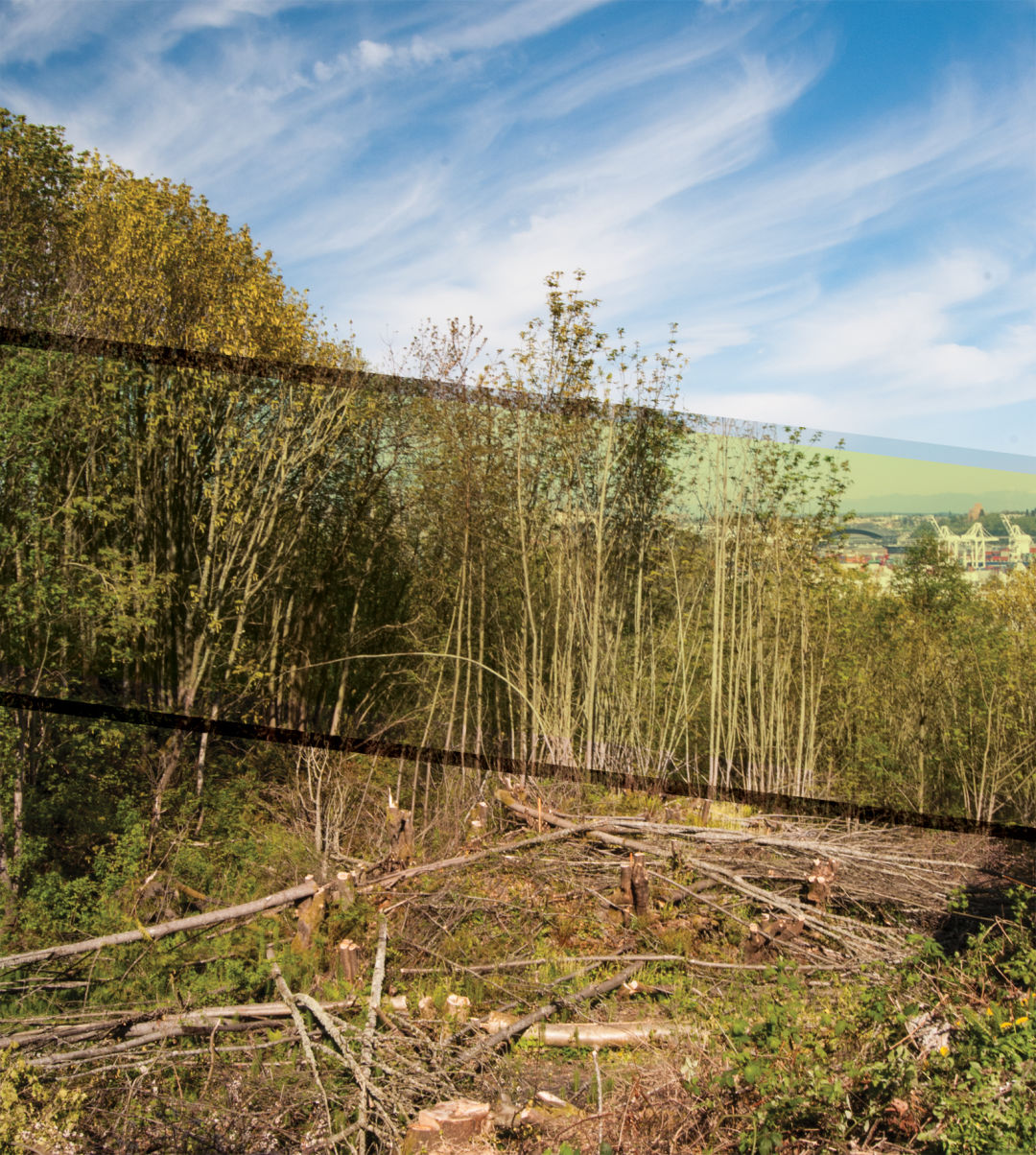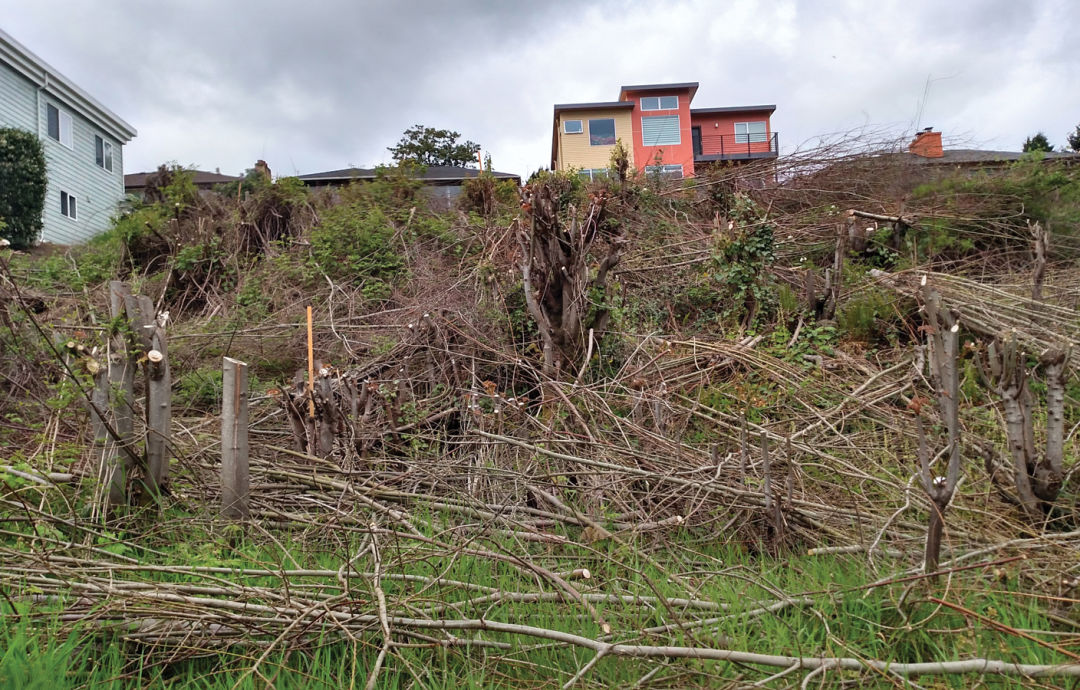Who Whacked 153 Trees in West Seattle?

Image: Sara Marie D'Eugenio
For years Charles King, 85, has watched the leaves sprout on the bigleaf maple trees behind his West Seattle home each spring. His modest brick house, built in 1949, is one of four homes in the Duwamish Head Greenbelt on the 3200 block of 35th Avenue Southwest. The maple trees, along with Scouler’s willow and other deciduous species, have supported a steep slope above Admiral Way for generations, preventing landslides and straining toxins from the nearby Duwamish industrial area.
But this year King looked out and saw stumps. They poked out from piles of scattered branches like gnarled fingers reaching up from a grave—the remains of 153 city-owned trees chopped illegally. “I miss them,” he says. “These trees are God’s trees. They don’t belong to me or the city or anyone else.”
King wasn’t home during the lumber jacking. His neighbors say they didn’t witness it either. It’s hard to imagine the sound of chain saws revving and trunks thumping to the ground going unnoticed; the neighborhood is otherwise quiet as a church. Yet no one we spoke to claims to have heard so much as a twig snap.
So what happened?
On January 15, 2016, City of Seattle arborist Nolan Rundquist received an email from a local, reporting the illicit harvest. But the Department of Transportation, which oversees greenbelts, didn’t respond until nearly a month later.
“We didn’t follow up to ask a clarifying question,” SDOT director Scott Kubly told the city council in a public meeting on April 7, “and we should have.” The email, he says, didn’t indicate the severity of the cutting.
In fact, until a homeowner came forward through an attorney to disclose his involvement, no city investigator had visited the site.
In a letter dated February 5 and addressed to Seattle Parks and Recreation superintendent Jesús Aguirre, real estate lawyer Clayton P. Graham claims his client and others hired a contractor to just prune the trees, not remove them. But when his client returned from a trip, Graham says, the homeowner discovered all the trees had been cleared.

Image: Sydney Parker
Who is this mystery clear cutter, and where are his silent coconspirators hiding? Was this the work of a wealthy real estate mogul? Arborcidal maniacs prowling with axes under cover of darkness? Colonel Mustard with the knife in the billiard room? Or was this all truly a terrible miscommunication between homeowner and contractor?
Until the SPD investigation is completed and made public, Seattleites can only speculate. To date, the name of the homeowner has not been publicly disclosed and the others at fault have not come forward. Visit the neighborhood, and you’ll meet folks who likely know who did it but aren’t the types to scream “timber” in a city-owned greenbelt.
The four homes on the hill overlooking the treeless gash, including Charles King’s brick home, are an eclectic mix of modest and palatial, retro and modern. Two of the homeowners, both next door to King, spoke with Seattle Met on condition of anonymity.
One, we’ll call her Nancy, moved into her charming 1960s-era home last year. The view of the serene Seattle skyline from her living room window is dazzling. But the vegetation carnage strewn below? Not so much. “I think what they did is egregious.” Or there’s the gentleman we’ll call Louis. “We liked the trees there,” he says. “We lost our privacy. We had to put up curtains in the back so people can’t see in.”
Or take retiree Eileen Carney (that’s her real name). She’s lived in her home on City View Drive, the hillside street perpendicular to the greenbelt, for 15 years. “I had a perfect view and the trees are starting to cover a lot of it now. So I sympathize with them”—whoever had the trees cut—“but guess what? That’s against the law, and if it’s against the law, you don’t do it.”
Finally, at the dead end of the street is a house with a gated entry and a swimming pool. The natural landscape surrounding the home is ravaged on two sides. According to King County public parcel records, the property is owned by an individual with ties to the real estate industry. When contacted for an interview, that homeowner declined.
“Whoever did this stole from every single Seattleite who is putting their tax money into the Seattle Park District,” says Merica Whitehall, executive director at Nature Consortium, a forest restoration organization based in West Seattle. “Regardless of whether you’ve ever gone to the Duwamish Head Greenbelt or give one ditty about it, your tax money is still going to preserve it.... If we allow private citizens to enact these kinds of crimes for the sake of improving the value of their property, then there will be many others who follow this same example.”
No, the clear-cut caper has not been solved, at least not as of press time, but one thing is certain: The culprits’ efforts were futile.
Charles King reports that now each morning he peers out his window and spots new tree growth sprouting from the earth.




